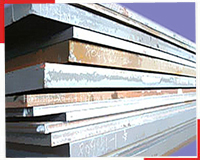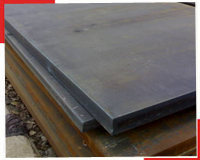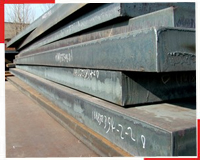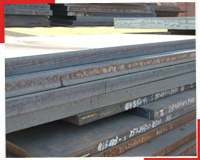- High Strength Quenched and Tempered Steel Plate
- High Yield Quenched and Tempered Steel Plate
- High Strength Structural Steel Plate,
- High Yield Structural Steel Plate
- High Strength Low Alloy Steel Plate
- HSLA
 We offers one of the largest ranges of high strength quenched and tempered structural steel plate in Europe. A variety of steel specifications is available including those with a minimum yield strength of 690 MPa and with a minimum yield strength of 890 MPa. The stock encompasses a range of sophisticated high strength low alloy steel plates from leading Western European producers and is supplied in plate thicknesses from 3 mm up to 300 mm. We offers one of the largest ranges of high strength quenched and tempered structural steel plate in Europe. A variety of steel specifications is available including those with a minimum yield strength of 690 MPa and with a minimum yield strength of 890 MPa. The stock encompasses a range of sophisticated high strength low alloy steel plates from leading Western European producers and is supplied in plate thicknesses from 3 mm up to 300 mm.
Specifications and grades
EN 10025 S690QL, EN 10025 S890QL, EN 10025 S960QL
RQT® 701, RQT® 901
Stock size range:
Thicknesses: 3 mm to 300 mm
Widths: 2000 mm, 2500 mm, 3000 mm
Lengths: Up to 12000 mm lon
Quenched and Tempered Steel Plate EN 10025 S690QL
 It is possible to produce steel plates that have more than twice the strength of those produced from mild steel through a heat treatment process known as quenching and tempering. Steel is heated to a point above its upper critical temperature and is then very quickly cooled in water. This method of cooling, known as quenching, induces a transformation in the crystalline structure of the steel which leaves it much harder. Unfortunately the steel in this condition is also very brittle and it is not possible to use it in many applications. A method of heat treatment for alleviating this problem is called tempering and requires the quenched steel to be re-heated although this time to below the lower critical temperature. The result is to put toughness and ductility back in to the steel and, although some of the yield strength of the quenched steel is lost, the end result of the quenching and tempering process is to produce a strong steel which is also easy to weld, bend, and fabricate generally. It is possible to produce steel plates that have more than twice the strength of those produced from mild steel through a heat treatment process known as quenching and tempering. Steel is heated to a point above its upper critical temperature and is then very quickly cooled in water. This method of cooling, known as quenching, induces a transformation in the crystalline structure of the steel which leaves it much harder. Unfortunately the steel in this condition is also very brittle and it is not possible to use it in many applications. A method of heat treatment for alleviating this problem is called tempering and requires the quenched steel to be re-heated although this time to below the lower critical temperature. The result is to put toughness and ductility back in to the steel and, although some of the yield strength of the quenched steel is lost, the end result of the quenching and tempering process is to produce a strong steel which is also easy to weld, bend, and fabricate generally.
Chemical Composition – EN10025 S690QL
Content % (ladle analysis), maximum
| C |
Si |
Mn |
P |
S |
B |
Cr |
Cu |
Mo |
| 0.20 |
0.80 |
1.70 |
0.020 |
0.010 |
0.005 |
1.50 |
0.50 |
0.70 |
| N |
Nb* |
Ni |
Ti* |
V* |
Zr* |
|
|
|
| 0.015 |
0.06 |
2.0 |
0.05 |
0.12 |
0.15 |
|
|
|
Mechanical Properties – EN10025 S690QL
| Plate Thickness
MM |
Yield Strength
ReH (MPa) |
Tensile Strength
Rm (MPa) |
Elongation
A5 % Minimum |
Impact Strength
J, Minimum |
| 3 to 50 |
690 |
770 - 940 |
14 |
30 @ -40º C |
| > 50 to 100 |
650 |
760 - 930 |
14 |
30 @ -40º C |
| > 100 to 150 |
630 |
710 - 900 |
14 |
30 @ -40º C |
Quenched and Tempered Steel Plate RQT 701
 Designers, engineers, and plant operators strive to reduce weight and increase the efficiency of equipment. There are significant benefits to be had by using high strength quenched and tempered steels for maximum structural performance in extreme working environments. Designers, engineers, and plant operators strive to reduce weight and increase the efficiency of equipment. There are significant benefits to be had by using high strength quenched and tempered steels for maximum structural performance in extreme working environments.
We often find that this type of material is called different things by different engineers. Plate to this specification and grade is variously described as:
- High Strength Quenched and Tempered Steel Plate
- High Yield Quenched and Tempered Steel Plate
- High Strength Structural Steel Plate,
- High Yield Structural Steel Plate
- High Strength Low Alloy Steel Plate
- HSLA
Chemical Composition – RQT® 701 Content % (ladle analysis), maximum - plates from 8 mm to 130 mm thick
| C |
Si |
Mn |
S |
P |
Cr |
| 0.20 |
0.50 |
1.60 |
0.010 |
0.025 |
1.00 |
| Mo |
Nb |
V |
Ni |
Cu |
B |
| 0.70 |
0.060 |
0.08 |
1.50 |
0.40 |
0.004 |
Carbon equivalent values
| |
Maximum Ladle CEV (%) |
| 8 mm to 30 mm thick |
0.43 |
| over 30 mm to 40 mm thick |
0.55 |
| over 40 mm to 100 mm thick |
0.59 |
| over 100 mm to 130 mm thick |
0.61 |
Mechanical Properties - RQT® 701
| |
8 to 70 mm thick |
over 70 to 130 mm thick |
| Minimum Yield Strength (Mpa) |
690 |
630 |
| Tensile Strength (Mpa) |
790 - 930 |
690 - 930 |
| Minimum Elongation 50 mm Guage (%) |
18 |
18 |
| Minimum Average Impact Energy |
30 J @ -40°C |
30 J @ -40°C |
| Minimum Individual Impact Energy |
21 J @ -40°C |
21 J @ -40°C |
Quenched and Tempered Steel Plate EN 10025 S890QL
 S890 steel is used in applications such as cranes (mobile and loader), aerial platforms, load handling equipment, bridges, and special containers. S890 steel is used in applications such as cranes (mobile and loader), aerial platforms, load handling equipment, bridges, and special containers.
We find that the category of steel plate that EN 10025 S890QL falls into is called different things by different engineers. Plate of this type is variously described as:
- High Strength Quenched and Tempered Steel Plate
- High Yield Quenched and Tempered Steel Plate
- High Strength Structural Steel Plate,
- High Yield Structural Steel Plate
- High Strength Low Alloy Steel Plate
- HSLA
Chemical Composition – EN10025 S890QL Content % (ladle analysis), maximum
| C |
Si |
Mn |
P |
S |
B |
Cr |
Cu |
Mo |
| 0.20 |
0.80 |
1.70 |
0.020 |
0.010 |
0.005 |
1.50 |
0.50 |
0.70 |
| N |
Nb* |
Ni |
Ti* |
V* |
Zr* |
|
|
|
| 0.015 |
0.06 |
2.0 |
0.05 |
0.12 |
0.15 |
|
|
|
Mechanical Properties – EN10025 S890QL
| Plate Thickness
mm |
Yield Strength
ReH (MPa) |
Tensile Strength
Rm (MPa) |
Elongation
A5 % minimum |
Impact Strength
J, Minimum |
| 3 to 50 |
890 |
940 - 1100 |
11 |
30 @ -40º C |
| > 50 to 100 |
830 |
880 - 1100 |
11 |
30 @ -40º C |
|